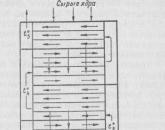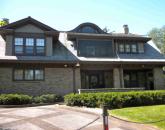Planer four-sided machine for timber characteristics. Quadrilateral Beam Profiling Machine
Modern construction technologies involve the use of high-quality lumber, which can rightly be attributed to profiled timber. This product is distinguished by a number of advantages (strength, ease of installation and excellent thermal insulation characteristics), which guarantees the high quality of buildings constructed on its basis.
However, for self-manufacturing timber (if it is impossible to purchase it in ready-made) required special equipment, namely, a four-sided woodworking machine.
Design features and purpose
Before proceeding with the manufacture of a four-sided machine at home, you will need to familiarize yourself with the design features of a typical planer unit.
The classic design of a 4-sided woodworking machine can be represented as a combination of the following main parts:
- mechanism for receiving and feeding blanks;
- type-setting section, consisting of a spindle with a cutting tool (milling cutter or knife saw);
- engine (gasoline or electric) with a drive;
- bodies for setting cutting parameters, adjusting, feeding and controlling the entire process.
Four-sided models are known, in which several spindles with a cutting tool are arranged in one row.
According to the peculiarities of their application, all known designs of machines for profiling boards and making beams are divided into two large groups, within each of which many intermediate options are possible.
Firstly, it is a portable (mobile) machine for profiling timber, which can be assembled by hand and is widely used at home or in small workshops. Its main advantage is mobility (the ability to move to the place of work), as well as good adaptation to any processing conditions. The disadvantages of such a 4-sided unit include the impossibility of expanding the range of products and low automation.
Secondly, it is a universal woodworking machine in a stationary design, which ensures the production of significant volumes of lumber. Stationary machines are usually equipped with CNC systems and a whole range of interchangeable cutting tools.
The four-sided stationary machine is designed to perform a range of woodworking operations, including milling (in this way it is similar to a milling tool), planing and planing, as well as thicknessing and profiling. With their help, it is possible to process the most different kinds wood raw materials and receive finished goods all kinds of names and sizes (bar, lamellas, rail and lining).
Feeder
The feeder of a modern four-sided machine with a planing function can be represented as follows.
The supply of wood blanks (future timber) is carried out by means of four drive rollers, and a set of upper and side clamps is responsible for its correct orientation in the direction of movement. The rollers located on top perform their function due to their own weight or under the influence of spring amplifiers.
Note! Adjustment of the size of the removed chips and profiling of workpieces is carried out by shifting the front of the table vertically.
Wood lumber is fed into the device in a continuous mode, in which the gap between the following one after another blanks is completely absent.
The latter is explained by the fact that even a slight gap in the supply will require a new filling in the rollers, which significantly reduces the productivity of the equipment and increases labor costs.
It is possible to increase the productivity of the entire four-sided woodworking machine as a whole by partially automating the receiving unit, carried out by combining the functions of positioning the board and its feed. It is usually set at a speed of about 8-22 meters per minute, however, in some modern equipment, this parameter has been increased by almost five times.
The number of revolutions of the cutting tool per minute averages 5-6 thousand units (in the latest models of the latest design, it has been increased to 9 thousand).
Processing zone and node
A typical processing unit of a four-sided woodworking machine contains upper and lower horizontally fixed shafts and a pair of vertically mounted spindles. Each of them has a cutting head equipped with a straight or shaped knife. The size of the workpiece is set by horizontal movement of the spindle (by changing the position of the cutting edge). When cutting boards, their thickness is set by the vertical movement of the upper shaft.
An additional (fifth) cutting or planing shaft can be included in the processing unit kit, which ensures the arrangement of the profile along the lower edge of the workpiece. To eliminate the effect of a wave formed on the surface of the tree from the circulating heads, special knives are provided in this zone. They provide an imitation of smoothing. Knives are made in the form of a block of blades fixed on the base of the table, mounted at an angle of 45 degrees to the feed plane and cutting about 0.02-0.2 mm of wood from the treated surface. Thanks to this arrangement of the knot, the wave crests remaining from the work of the jointer are completely cut off.
Control system
The operation of four-sided stationary wood equipment is usually controlled from a remote control, however, such a system is not suitable for a home-made device.
Note! In the case of self-manufacturing of the machine, the main thing is to provide mechanisms for setting the size of the workpieces and the speed of their supply to the cutting zone.
In addition, it is necessary to provide the ability to set the position of a set of spindles relative to the part, as well as varying the type and diameter of the cutting tool. One should not lose sight of the mandatory presence on the machine of the tree of functional elements responsible for turning it off and on.
Homemade machine (option for profiling timber)
A four-sided profiling machine must include such required elements, as a base (bed), a drum with a set of knives and an electric or Gas engine. In addition, it must be provided with a movable frame, which has the ability to adjust the size of the workpiece according to the processing height, as well as special fixing and locking elements.
When manufacturing a device for profiling blanks with dimensions of 150 x 150, it is necessary to select a sufficiently powerful engine with suitable characteristics. For the stated purposes, a Honda gasoline unit with a capacity of 6.5 horsepower, developing up to 3600 rpm, is quite suitable.
After choosing the engine, you should prepare a set of metal plates, corners and channels and weld a frame structure from them according to a previously drawn up sketch, on which the selected unit must be securely fixed.
From the motor shaft, the torque is transmitted to the knife drum through a system of pulleys. All these parts can be removed from old non-working machines or ordered in the workshop, having previously prepared their drawings.
The movable frame must move along specially prepared guides with rollers built into them (they are attached to the corners of the structure). In total, it is necessary to provide four rollers fixed from its lower part.
The supply of workpieces is carried out in a home-made device manually (due to the muscular strength of the operator). To change the height and depth of processing within 5-10 cm, the engine with the knife drum must move freely vertically to the limit stops.
It should be noted that before manufacturing a woodworking machine with four-sided processing, it is necessary to carefully study the theoretical material and practical implementation options. Only under this condition it will be possible to produce a reliable working structure that guarantees the solution of the task assigned to the user.
- Distinctive characteristics of the production of profiled timber
- Milling woodworking machine
- Machine SPB-200
- Machine SPB-200A
- Machine VPK340 and VPK
- Profiling - canting machine Wood-Mizer MP-100
Profiled timber is made according to the technologies of our time, using modern equipment. Log houses are environmentally friendly and have high-quality thermal insulation. Its correct geometric shape makes it possible to build both large cottages and small buildings from this material. All this makes the production of repair profiled beams now very cost-effective. The machine for the manufacture of profiled timber, although expensive, is instantly reimbursed. This makes everything much more interesting for individual traders like this business. What equipment is needed for the production of corrugated timber and how much does a machine for the production of corrugated timber cost, let's look at it in detail.

The production of profiled timber is a very multi-stage and not an easy process. For its implementation, a machine is required in order to manufacture. They make this product from softwood, for example larch, cedar, spruce, pine.
In the first stages, all raw materials are sorted in production and are already selectively fed to the frame machine. There, the tree trunk is peeled and sawn off.
Often, more than one type of technique is used to make. One of these machines is the apparatus for profiled timber. The log is sawn from four sides and then it is profiled. To obtain a dry bar before profiling, the raw material enters special chambers. And only then profiled.
All production of profiled timber can be divided into stages:
- Finishing raw materials on a multi-blade machine.
- Finishing on a four-sided milling machine, where the bar is planed and profiled.
- Designation and trimming of a ready-made profiled beam.
- A cup is cut out, an interventional connection.
Milling woodworking machine

But there are machines that allow you to do all these stages on one machine with one log installation. Machines of this type are called milling multifunctional devices. This technique is equipped with removable tools that change before each new finishing step. The quality of the resulting profiled timber is affected by the quality of the cutter used on similar equipment.
Grooving knives on a similar machine are of a removable type and have a different profile. Therefore, without much effort, you can get a thermal lock from a conventional single-groove to a complex “comb” shape. This provides an increase in the range of goods in production to the limit and increases the profitability of production.
It is necessary to consider briefly the very popular models of machines for the manufacture of profiled timber.
Bar profiling machine SPB-200

This technique is necessary for the processing and profiling of raw materials of natural moisture and dry. Used for woodworking with a width of up to 220 mm.
This mechanism is made up of:
- Bar support.
- Stops and clamps.
- Carriage with traverses placed on it.
- Motor.
- Cutters.
Important properties of the SPB-200 machine can be presented in the form of a table:
Feature
Meaning
the number of many majorities
2 pcs.
4500 rpm
7.5 kW
Machine size
9000x1400x1200
Weighs
550kg.
The advantages of this equipment:
- The cost is low compared to similar devices.
- It is possible to finish both dried bar and natural moisture.
- Unlike 4-sided machines, it corrects the curvature of the workpiece.
- Can be placed on a small area, 7 meters.
- Replaceable cutters.
- Has a great payback.
Work on SPB-200, see the video:
The cost of such a machine in the Russian Federation is now on average 145-250 thousand rubles.
Machine for the production of profiled timber SPB-200A
This technique is used for processing and profiling a bar from 4 sides. This version of the machine is intended for finishing material of natural humidity or dry workpieces with dimensions of 200x250 mm. Suitable for a small private farm, as well as for a huge sawmill. The machine has a small size, which makes it possible to put it on an area of 11 meters.
Important properties of the machine can be represented in the form of a table:
Feature
Meaning
Number of cutters
2 pcs.
The frequency with which the cutter rotates
4580 rpm
Required electrical power
7.5x2 kW
Machine size
10500x1300x900
Weighs
760kg.
Advantages of this machine model:
- Calibrated guide frame.
- Easy replacement of one nozzle for another.
- Not very difficult to operate and maintain.
- Small cost.
It costs an average of 150-165 thousand rubles in R f. The operation of such a machine can be seen in the proposed video:
Bar profiling machine VPK340 and VPK
This complex includes two machines. Both of them have four horizontal milling heads. The material is profiled using a similar technique from 4 sides. In the mechanism of the technique itself, the milling heads first process the bar vertically and then horizontally. In pairs, machines are used to finish 4 blanks at once.
Important properties of the complex of machines can be viewed in the form of a table:
Feature
VPK340 value
VPK value
Number of cutters
4 things.
4 things.
The frequency with which the cutter rotates
4700 rpm
4750 rpm
Required electrical power
2×110kW
2×75 kW
Machine size
13500x11000x1000
14500x11500x1000
Weighs
10.4t
14.4t
The advantages of this complex:
- You can trim 4 blanks in parallel.
- Processes the bar from four sides to a depth and adjustable height.
- Has good power.
Each machine from the complex costs 100-150 thousand rubles, which means the cost of the complex will be approximately 300 thousand rubles, but since productivity will also be twice as high, the payback is relatively rapid.
Profiling - canting machine Wood-Mizer MP-100
This technique is necessary for companies that have a small production of profiled lumber. It has a frame where the workpiece is loaded with the help of a saw carriage, and a cutter log. Load the workpiece on such a machine manually no need, since it is automated.
Since the cutters of this technique are adjustable, you can get up to 10 types of profile. This provides production with an immediate increase in choice, which means increasing consumer interest. And due to the automation of loading and unloading of the machine, labor productivity will be increased by approximately 30%.
Feature
Meaning
Number of cutters
4 things.
The frequency with which the cutter rotates
4890 rpm
Required electrical power
4x2 kW
Machine size
9500x11500x1000
Weighs
10 t
Purchase this equipment in the Russian Federation from companies involved in timber processing automation. This kind of car costs from 350-400 thousand rubles.
If we declare the cost of machines for the production of profiled material, then they depend on the power and practicality of the equipment. But the more purposes such equipment has, the more profitable the production will be. And this will attract customers and give a quick payback for the enterprise itself.
1. The main advantage of the design of the flagman 4x240 beam profiling machine is very reliable workpiece feeding system in processing: a long pusher on the carriage pushes the workpiece through all the spindles, providing a constant force and feed speed, which is impossible to achieve using feed rollers and ripples. Accordingly, a stable surface quality is ensured over the entire length of the resulting timber. A frozen or not too even beam - it does not matter for the pusher, the feed is guaranteed to be stable and clear. The return of the pusher to its original position occurs on top speed in 10 - 15 seconds.
Only such a feed system allows the production of complex sections, for example, with one or even two side semi-circular sides for a "block house", while guaranteeing accurate geometry and complete absence dents and other marks from the feed rollers on the finished product.
2. Feeding by a pusher also allows you to increase the "foolproof": the force on the pushing carriage is transmitted by means of a chain (rail) rigidly fixed on the feed table and a drive sprocket. The sprocket is pressed against the chain by a spring, and at a certain rolling resistance (for example, someone forgot to reconfigure the pressure rollers to a larger section), it simply wins back, disengages from the chain and turns. This solution protects the elements of the machine from careless handling.
3. The position of all working elements of the machine: spindles, table surface, pressure rollers and rollers, guide rails are adjustable. You can always set the optimal relative position of the elements for comfortable and high-quality processing of workpieces of a wide range of sections.
4. The design of the machine frame, in addition to the required rigidity, also provides quick and easy access to all elements of the machine: adjustment, maintenance and, if necessary, replacement of machine parts are not difficult and will not require much time.
5. Adjustable workpiece feed rate allows you to select the optimal operating modes depending on various conditions: workpiece section size, removal depth, rock hardness, etc.
The production of profiled timber requires not only knowledge and the use of a high-quality raw material base, but also the operation of modern, accurate and durable equipment - machines for profiling timber and cutting cups for corner joints in it. This article provides a small overview of such equipment, its characteristics are announced and approximate prices are indicated.
Popular models of machines for the production of profiled timber
Below we have reviewed the most popular models of machines designed for the manufacture of profiled timber. All presented equipment is mostly suitable for small and medium-sized enterprises. Among them there is one that will appeal to those craftsmen who are ready to take on when building their own house. As you understand, and the prices for various machines for profiling timber differ significantly.
OS4-500 timber profiling machine
OS4-500 can be used both for the manufacture of OCB, and for profiling glued or solid timber, i.e. this is a universal solution. We will not dwell on the description of the capabilities of this machine in terms of the production of rounded logs, focusing only on profiling. It is enough to replace the spindle sockets of the cutters, install cutters with knives, and you can carry out double-sided profiling of the timber. Max Height finished timber will not exceed 200 mm. This machine must be operated by at least two people.
| Options | Values | Max D blanks, mm | 500 | Max section of the workpiece, mm | 200×400 | Min section of the workpiece, mm | 80×80 | Min L blanks, mm | 2000 | Max L blanks, mm | 6500 | Max H of beam profiling, mm | 200 | Average productivity, m/min. | 3 | Weight, kg | 1400 | Overall dimensions, mm (working condition) | Length | 9000 | Width | 1880 | Height | 1800 | Approximate price for a machine for profiling timber (milling cutters and knives for profiling timber are not included in the price) | 400000 rub. | ||||||||||
|---|---|---|---|---|---|---|---|---|---|---|---|---|---|---|---|---|---|---|---|---|---|---|---|---|---|---|---|---|---|---|---|---|---|---|---|---|
Four-sided machine SPB4
Unlike the previous solution, this machine is designed only for the production of profiled timber, both from solid and glued. SPB4 can be equipped with cutters of the required profile or drums with knives for the production of timber with a large cross section and special geometry, as well as feeding and receiving tables (optional). The processing of the workpiece is carried out using four milling blocks arranged in pairs - horizontally and vertically. Can be operated by just one worker.
Machine for the production of profiled timber SPB-200
A relatively simple and inexpensive machine for the manufacture of profiled timber, SPB-200 allows you to produce up to four bars per hour. At the same time, the equipment is used both for planing and for profiling timber and allows you to effectively process workpieces with geometric defects. The maximum width of the profiled timber is 220 mm. Surface treatment is carried out sequentially.
Machine tools SF-250 "Profile"
These machines are designed for the production of profiled timber by flat and profile milling of the workpiece. It is produced in three versions: SF-250 "Profile" for processing from 3 sides, SF-250 "Profile" Economy for processing from both sides, SF4-250 "Profile" for four-sided milling.
Machine for the production of profiled timber UFC-1
A feature of this machine is that it can produce profiled timber directly from the feedstock - saw logs. It turns out that UHF-1 replaces several machines at once. We think that it is not necessary to explain all the advantages of this approach, especially for small and medium-sized enterprises.
About cup cutters for timber
Assessing the market for cup cutters for profiled timber, we noticed that most models are focused on serious production and manufactured foreign companies. A domestic manufacturer, for example, IzhKomStanko, offers low-performance machines: MChS-B and MChS-2B. True, their cost is relatively low in comparison with foreign equipment: 100 and 150 thousand rubles for a single-sided and double-sided milling machine, respectively. Another option is to use the so-called mobile cup cutter Brus-1, it costs even less: about 30 thousand for the design + the cost of the milling machine.
Popular
- Where to get start-up capital for a business
- How to name a company: examples of names
- Making money in Sims
- How to make money while traveling How to make money while traveling
- All profitable business niches
- All profitable business niches
- Top bucks that pay in dollars
- Earning on comments
- Similar to vktarget. Vktarget reviews. How to get more tasks on the VKtarget project - basic recommendations
- How to start earning in the game Farm Neighbors?




